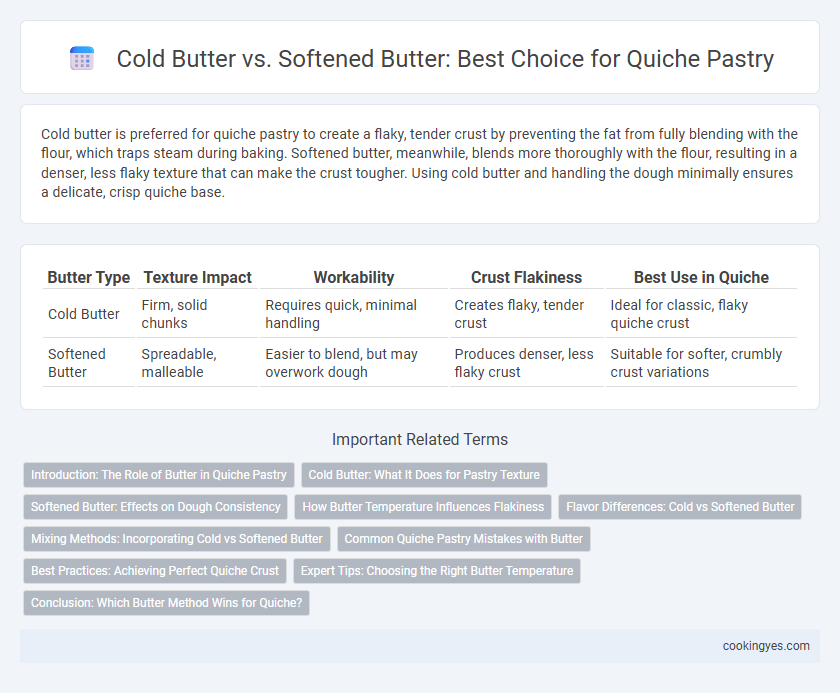Cold butter is preferred for quiche pastry to create a flaky, tender crust by preventing the fat from fully blending with the flour, which traps steam during baking. Softened butter, meanwhile, blends more thoroughly with the flour, resulting in a denser, less flaky texture that can make the crust tougher. Using cold butter and handling the dough minimally ensures a delicate, crisp quiche base.
Table of Comparison
| Butter Type | Texture Impact | Workability | Crust Flakiness | Best Use in Quiche |
|---|---|---|---|---|
| Cold Butter | Firm, solid chunks | Requires quick, minimal handling | Creates flaky, tender crust | Ideal for classic, flaky quiche crust |
| Softened Butter | Spreadable, malleable | Easier to blend, but may overwork dough | Produces denser, less flaky crust | Suitable for softer, crumbly crust variations |
Introduction: The Role of Butter in Quiche Pastry
Cold butter creates a flaky, tender texture in quiche pastry by producing distinct layers as it melts during baking. Softened butter, while easier to blend, can result in a denser, less crisp crust due to its uniform integration with the flour. The choice between cold and softened butter significantly influences the quiche's structural integrity and overall mouthfeel.
Cold Butter: What It Does for Pastry Texture
Cold butter in quiche pastry creates a flaky and tender crust by forming distinct layers as it melts during baking, resulting in a light, airy texture. The solid butter particles prevent excessive gluten development in the dough, ensuring a crisp and crumbly bite. Using cold butter is essential for achieving the classic delicate structure ideal for savory quiche shells.
Softened Butter: Effects on Dough Consistency
Softened butter in quiche pastry dough creates a more pliable and cohesive texture, making the dough easier to roll and shape. This results in a less flaky crust compared to cold butter, as the softened fat integrates more thoroughly with the flour. The dough tends to be more tender but may lack the characteristic crisp layers that cold butter imparts in traditional quiche crusts.
How Butter Temperature Influences Flakiness
Cold butter creates steam pockets during baking, resulting in a flakier quiche crust as the solid fat melts slowly and releases moisture. Softened butter blends more thoroughly with flour, producing a denser, less flaky texture due to the lack of distinct fat layers. For optimal flakiness, using cold butter chilled from the refrigerator is essential.
Flavor Differences: Cold vs Softened Butter
Cold butter in quiche pastry creates a flakier, more tender crust by maintaining distinct fat layers that melt during baking, enhancing texture and flavor. Softened butter blends more thoroughly with the flour, yielding a denser, less flaky crust with a richer, buttery taste. The choice between cold and softened butter significantly influences the pastry's mouthfeel and flavor profile in quiche recipes.
Mixing Methods: Incorporating Cold vs Softened Butter
Cold butter in quiche pastry creates a flaky texture by forming small pockets of fat that release steam during baking, achieved through cutting or rubbing the butter into the flour until pea-sized lumps remain. Softened butter blends more uniformly with the flour, producing a tender, less flaky crust by coating flour particles evenly, ideal for a crumbly, biscuit-like base. The choice between cold and softened butter significantly impacts the pastry's texture and handling, with cold butter suited for classic flaky quiche crusts and softened butter favored for a delicate, shortcrust finish.
Common Quiche Pastry Mistakes with Butter
Using cold butter for quiche pastry creates a flaky, tender crust by preventing excessive gluten development, while softened butter can lead to a dense, tough texture due to over-mixing. A common quiche pastry mistake is incorporating butter that is too warm, which causes the dough to become sticky and difficult to handle. Ensuring butter stays cold and is cut into small, pea-sized pieces improves crust flakiness and overall quiche quality.
Best Practices: Achieving Perfect Quiche Crust
Cold butter is essential for a flaky, tender quiche crust because it creates steam pockets during baking, resulting in a light texture. Softened butter blends more thoroughly with flour, producing a denser, less flaky pastry unsuitable for delicate quiche shells. Using cold butter, cut into small pieces and incorporated quickly, ensures optimal crust structure and crispness.
Expert Tips: Choosing the Right Butter Temperature
Cold butter creates a flakier quiche pastry by releasing steam during baking, resulting in distinct, crisp layers essential for professional-quality crusts. Softened butter blends more easily with flour, yielding a tender but less flaky texture suited for a softer quiche base. Experts recommend chilling the dough thoroughly after incorporating cold butter to maintain pastry structure and prevent shrinkage during baking.
Conclusion: Which Butter Method Wins for Quiche?
Cold butter creates a flaky, tender quiche crust by releasing steam during baking, resulting in distinct, crisp layers. Softened butter blends more evenly into the dough, producing a denser, more uniform texture that is less flaky but easier to handle. For traditional quiche pastry, cold butter is preferred to achieve the characteristic delicate, buttery layers that enhance the overall eating experience.
Cold butter vs Softened butter for quiche pastry Infographic

 cookingyes.com
cookingyes.com